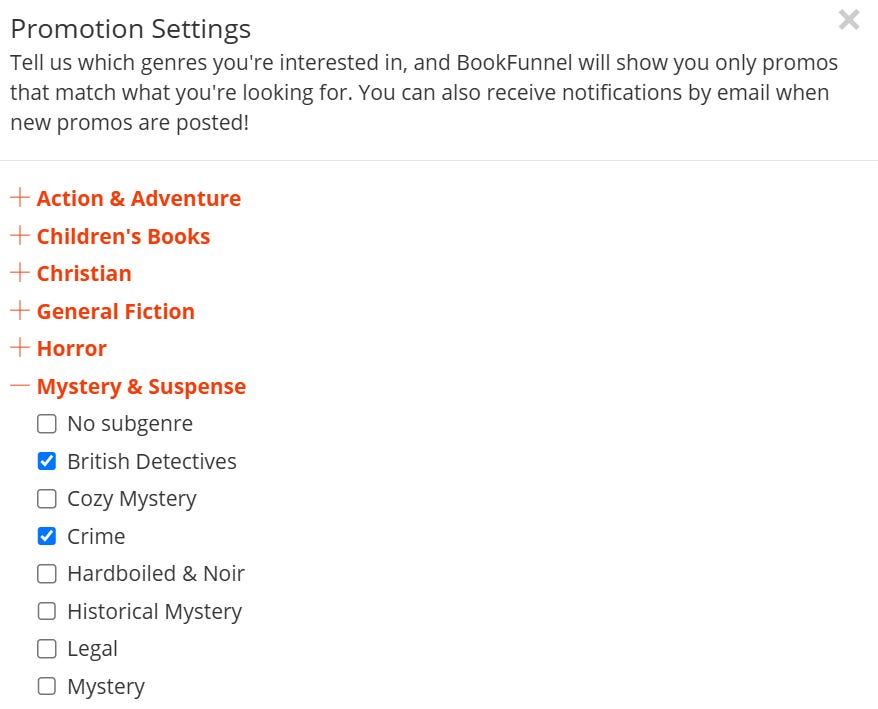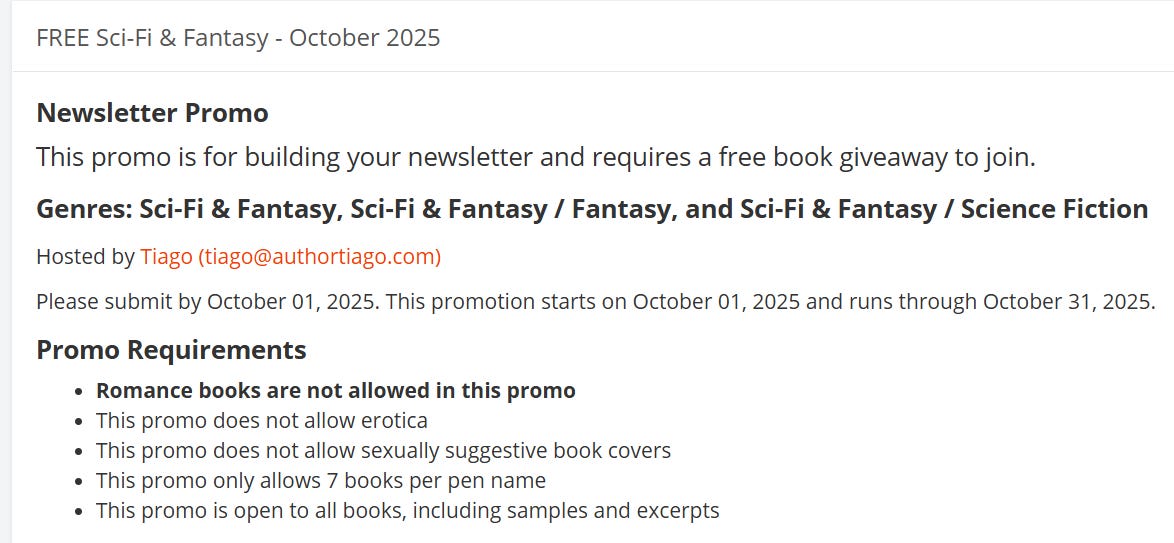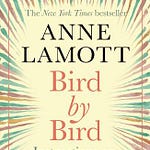The trap of Substack is to think that it should do all the hard work for you. When writers complain that they’re growing too slowly, or that Substack’s algorithm is broken, or that nobody sees their Notes or reads their newsletter — my question tends to be “what else are you doing?”
Substack has built a range of networking and promotion tools which I’ve found very useful at various times. But I’ve always thought of them as bonuses. A decade+ of legacy social media I think trained us to always be at the mercy of The Platform, but it doesn’t have to be that way.
I built the foundation of this newsletter using BookFunnel group promotions. I started Write More in 2021, and the first year-and-a-half of subscriber growth was powered entirely by BookFunnel. Remember that Substack Notes, and the Recommendation system, didn’t exist back then, and Substack’s userbase was much smaller than it is now.
What is BookFunnel?
BookFunnel is a toolkit for indie writers, providing a bunch of promotion and distribution features. It makes it easy to deliver ebooks to customers, and collaborate with other writers.
The main feature I’m looking at today is the group promo. I’ve found this to be effective and useful at building a newsletter, and generally more reliable than other promotional options like paid ads.
Know that BookFunnel is not free. To use its main features requires a subscription.
If you’re only using BookFunnel to provide a pleasant book delivery experience for your readers, it’s $20 per year. For what we’re talking about here, the group promos, you’ll want the $100 per year option, which enables the collection of email addresses.
$100 per year is not nothing, so you’ll need to decide for yourself whether it’s worth the investment. This is hardest when you’re just starting out: you are likely not making any money from your writing, so the idea of spending money on something as ephemeral as ‘writing’ feels like an indulgence. Perhaps think of it as an investment in yourself and your writing: a way to construct a foundation upon which you can build.
Of course, let’s recognise something up front: as with all paid promotion, there is no guarantee this will work. Only spend money that you can afford to lose.
I used BookFunnel for about two and a half years, which would have cost about $300. Those promos brought me over 1,000 subscribers, which works out to about $0.28 per subscriber. I’m OK with that, especially as these were good leads — readers that were genuinely interested in the newsletter. A traditional ad campaign wouldn’t reach the right people so effectively.
There’s a longer term benefit, which is harder to quantify directly. Those 1,000 initial subscribers would have gone on to spread the word, accelerating Write More’s early growth. Would I be at 9,000 subscribers now without that initial BookFunnel-powered start? Would I have paid subscribers now, if I hadn’t invested at the start?
I don’t have definitive, data-driven answers, but I’m inclined to think that the BookFunnel promos were a good early tactic. To get a similarly high quality result with paid ads on, say, Facebook would likely have cost closer to $100 per week.
What is a group promo?
Here’s how it works:
Group promos are themed around particular genres or subjects, presented to readers as giveaways
Lots of writers sign up to take part, contributing a book, extract, sample etc to the promo
The group promo takes place over a specific time period, usually a month
During that month, every author taking part makes sure to promote the group promo in their newsletter and on social media
Readers show up on the promo page to check out what’s on offer, and get to choose from all the books that have been contributed
In exchange for a free book, the reader signs up to that author’s newsletter. Note that this is author-specific: if someone downloads my free sample, I get their email address. None of the other authors taking part get that reader’s email address (unless they also grab books by other authors).
At the end of the promo (or during), authors download the email addresses of readers who signed up, and can import them into their newsletter system
Readers have cool new stuff to read, for free, and will also be signed up to interesting newsletters
It’s really a win-win situation. There’s nothing scammy about it, it’s very clear to readers what they’re signing up for and getting. From a data privacy point of view it works very cleanly: the authors all work together to promote the giveaway, but only receive emails specific to their book(s).
There’s a big multiplier effect at work: the giveaway is more enticing for readers because it has a wide range of books from a big selection of writers. The promo reaches a lot more people than it would if writers were working alone.
Back when I started, I had a couple hundred subscribers, so I benefited hugely from authors with bigger lists. I’m gearing up to try some new promos in July, and I now have 9,000 subscribers. This time round, I can contribute more eyes to the promo. Throw in some other authors with similar-sized lists, or bigger, and it starts to scale up significantly.
What is a reader magnet?
The concept of a group promo relies on the ‘reader magnet’. This is the freebie that you’re giving away, in exchange for someone signing up to your newsletter.
If you’re just starting out as a writer, this can be the tricky bit. It’s much easier if you’ve been writing for a while and have a back catalogue you can lean on. Some things to consider:
You want the reader magnet to be relevant to your newsletter. Ideally you want continuity, so that anyone who likes the look of your freebie will naturally also enjoy your newsletter.
Some promos require full books to be given away. Others are fine with samples or extracts. This is made clear when you’re signing up.
The freebie needs to fit the theme of the promo. Don’t try to use a romance novella in a science fiction giveaway.
Your freebie needs to be professionally presented, with a not-awful cover1 and a high quality interior (ie, not full of spelling mistakes!).
I’ve used a range of reader magnets over the years. An ebook of my How to write serial fiction guide was good for reaching people interested in the non-fiction side of what I do. I’ve given away samples of No Adults Allowed. Probably most effective has been using the opening chapters of Tales from the Triverse, which works as the perfect lead into the regular newsletters.
Using Triverse obviously required me to write it first! You might find you’re in a similar position, and need to plan ahead to a point when you’ll have the right material.
How does it work?
Step-by-step, then.
Once you’ve signed up to an appropriate plan, you can head to your dashboard where you’ll find all sorts of options. The one we’re talking about is group promos:
However! First you need to do a bit of prep work. For starters, you need to create your book. Once in the Books section, you can add a new book:
You’ll be asked to fill in a bunch of info, all of which is fairly standard and self-explanatory:
After this you’ll need to add the actual ebook files. If possible, add an epub and PDF version, so that readers can download which one works best for them.
If you’re not sure how to create those files, my post from last week is the one to check out, where I show how to use the free Reedsy editor to prepare your ebook files:
A quick and easy way to format your ebook and paperback files
Sometimes you want a tool that is simple, fast and does the job without unnecessary frills. That’s what I needed this week, to prep an ebook for use in upcoming BookFunnel promotions.
Something that caught me out the first time using BookFunnel is that creating your ‘book’ is step one. Each book in your account then needs a ‘landing pages’, which is what a reader actually sees when they go to download the thing.
There’s a bunch of options here, but for the kind of promo we’re talking about you want to make sure you’ve selected Reader must sign up for a list to get the book. This means that they will need to sign up to your newsletter in order to download the free book.
There’s a bunch of formatting decisions to be made which will determine the look of the landing page. I’d suggest using the details you’ve already entered for the book, so as to keep things simple:
It ends up looking something like this:
To get to that, readers would first arrive at the promo page, listing all the books on offer, then pick the titles that look interesting.
Once you’ve got your book and landing page set up, you can move on to the actual promos.
First you’ll then want to set up your promotion settings, which involves choosing from a long list of genres and sub-genres:
You can take part in any promo which makes sense for your work. The settings here are to filter the group promos you see in the listing, so that you’re not having to sift through a ton of irrelevant stuff.
On the group promos page of the dashboard you’ll now see a filtered list of the upcoming promos. It’ll look something like this:
You can join as many as you want, but bear in mind it will be your responsibility to help promote any group promo you join. If you join too many within the same time period, it could diminish the effectiveness of any promo you do, or annoy your existing readers.
Clicking on a promo reveals its details. You need to read these carefully to make sure that you’re a good match. Here’s an example:
You’ll find a lot of non-romance genres explicitly forbid romance novels. If you’re a romance writer, don’t despair, as there are many romance-specific promos you can join.
Some promos have ‘reputation’ requirements, or rewards. As you take part in promos, you’ll build up a reputation based on how many readers you send to the promo. The more readers you send per promo, the higher your rep. Mine is actually fairly low, because when I last used BookFunnel I still had a relatively small list. I’m hoping to be able to contribute more significantly to the promos I’m doing next month July.
If you’ve not used BookFunnel before you will not yet have a rep. This might make some promos off-limits until you’ve ‘proven’ your ability to drive clicks, but there’ll always be some promos which are happy to welcome newcomers.
If this all sounds stressful, don’t worry! The whole point of BookFunnel is to streamline the process and make doing this really easy. You have a custom link to include in your newsletter, and organisers often provide banners and other images as well.
When joining a promo you’ll commit to a date on which you’ll promote the event. For example, I send out newsletters on Mondays and Fridays, so normally pick a date in the first half of the promo that fits in with my schedule.
Once you’ve signed up to some promos, you get a handy calendar to help you keep track:
The stars here show when I’ve promised to promote the group promo. I can do it on other days as well, of course, but those are my specific dates. Everyone else involved in the promos will be simultaneously pushing out their own notifications, and hopefully we’ll collectively get lots of potential new readers swinging by.
Once the promo wraps, you download your new email sign-ups and import them into Substack, or your newsletter platform of choice.
And that, as they say, is that.
There’s a lot more to BookFunnel, but the group promos are the feature I’ve used the most. I hope it proves as useful to you as it did to me in the early days.
I’m taking part in promos this July, which is the first time I’ve used BookFunnel in quite a while. For a long time it became largely unnecessary, as I was enjoying organic growth simply through word of mouth and the Substack network. This has dried up in the last couple of months, so I thought it was a good time to see how effective BookFunnel is in mid-2025.
I’ll let you know.
Meanwhile.
A few weeks back I published a chapter of Triverse which seemed to hit a nerve. I had messages from a bunch of people who had never read any of the series before, but decided to hop in on this particular chapter. Despite it coming three and a half years into the series’ run, it apparently made sense and was effective. So if you’ve been wondering about checking out my fiction, this might be the one.
I should warn you that it’s a bit grim. Here it is:
I’m down in London this week for work, which often means I actually have more time to write due to being on a train. Which is good, as Triverse chapters are consuming an enormous amount of my brain fuel at the moment.
Right, see you on Friday for more Triverse.
That said, the quality of covers does tend to vary. Such is the indie publishing scene.


























